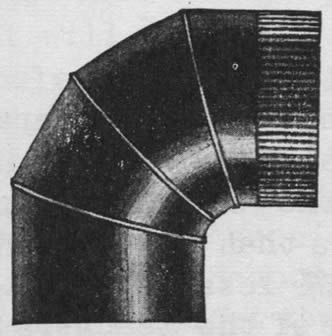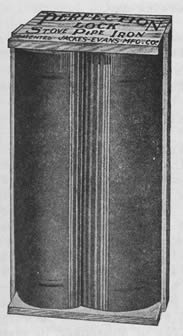Volume 2, Number 3 - Spring 1965
Taking Down the Stove
by Dorothy Cummings
The Spring season turns man into a blithe spirit, bringing out the best in him as he happily looks forward to sunnier days. Having made it through another winter, his mood is lighter, more frivolous as Spring’s magic has its way with him. It has always been so--except for that gloomy era which began when Franklin’s stove edged out the old-fashioned fireplace and lasted until the stove was replaced by the automatic furnace. As long as man’s house was warmed by the wood or coal burning stove, Spring was a season whose perfection was marred by the dread of that one day as cloudy and black as soot--the day for taking down the stove.
Exasperated men wrestled with the clumsy stoves and, as their religious scruples gave way, their curses were fearsome to hear. We recall a Taney County farmer--well known for his serenity of temper and gentleness of manner--who, when the soot-laden stovepipe broke over his head, swore so heartily that his wife admonished him to remember the patience of Job. "Job," he said bitingly, "never had to take down a stove!"
There was no set date for the dreaded chore, but it was an era when it was a matter of pride among housewives to be the first to hang the wash on the line Monday mornings, or to have the first roasting ears from the garden. Thus, it was also a contest each Spring to see which family could safely be first in clearing the front room or parlor of the heating stove.
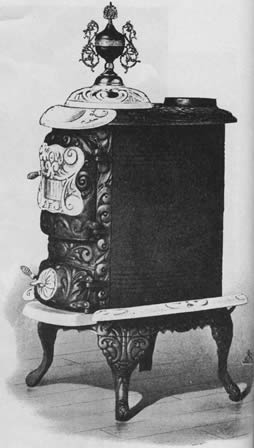 IMPERIAL AIR TIGHT HEATER
21-inch, weight 85 lbs...... $15.00
These stoves have heavy polished steel bodies, cast top, cast pipe collar, cast front, cast bottom, high, cast interchangeable adjustable lining, nickel foot rails, nickel swinging covers, fancy urns, hole in top for heating water, full nickel front, large feed and draft doors, nickel screw draft register and nickel ash guard. Large heavy cast feet, with heavy cast base rail, being an extension of the cast bottom. Fitted with cast smoke curtains, inside feed door.
IMPERIAL AIR TIGHT HEATER
21-inch, weight 85 lbs...... $15.00
These stoves have heavy polished steel bodies, cast top, cast pipe collar, cast front, cast bottom, high, cast interchangeable adjustable lining, nickel foot rails, nickel swinging covers, fancy urns, hole in top for heating water, full nickel front, large feed and draft doors, nickel screw draft register and nickel ash guard. Large heavy cast feet, with heavy cast base rail, being an extension of the cast bottom. Fitted with cast smoke curtains, inside feed door.
[12]
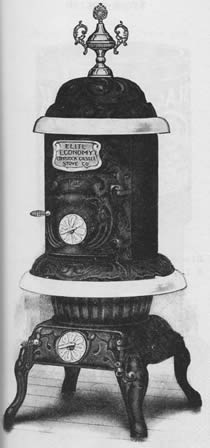 ELITE ECONOMY ROUND OAK HEATER
16-inch, weight 119 lbs...... $16.00
This stove has heavy sheet steel body, draw center grate, heavy cast fire bowl, draft registers in feed and base doors, nickel top ring, nameplate, foot rails and knobs. Heavy cast middle ring, bronzed and japanned urn and side opening for grate shaker. Each stove is fitted with ash pan. All these stoves are well braced with 1/4-inch iron rods which prevent the steel jacket from becoming displaced.
ELITE ECONOMY ROUND OAK HEATER
16-inch, weight 119 lbs...... $16.00
This stove has heavy sheet steel body, draw center grate, heavy cast fire bowl, draft registers in feed and base doors, nickel top ring, nameplate, foot rails and knobs. Heavy cast middle ring, bronzed and japanned urn and side opening for grate shaker. Each stove is fitted with ash pan. All these stoves are well braced with 1/4-inch iron rods which prevent the steel jacket from becoming displaced.
Of course in each community, there were a few people who ignored the contest and left the stove brooding sullenly at the end of its black pipe all summer long. But that was generally considered to be a shiftless unhealthy practice, and women in mentioning it to each other would remark that they dreaded going into such people’s houses with "that dirty old heating stove still up and smelling of cold ashes."
Timing was of the utmost importance. The discussions of when to take down the stove usually began in early April, since March, even with its warm sunny days, was a month too treacherous to trust. All Ozarkers know that our Springs can often be marred by a late snow or sleet storm and, if the stove came down too soon, a family could spend some uncomfortable hours in a house heated only by the cook-stove in the kitchen--not to mention having to endure the jibes of neighbors who had been smart enough to leave their stoves up until "the weather settled".
The women of the family were usually the first to mention the subject of the stove. Its coming down was an important, nay, vital part of the ritual of spring cleaning and the sooner done, the better. The room in which the stove stood could not be touched until it was out of the way and if the man doing the job was clumsy enough to drop a stovepipe and shower soot about, any house-cleaning done before would have to be done over.
In the opening discussions as to when would be the best time, the man of the house seemed each year to be taken completely by surprise that the stove had to come down at all. As the necessity for the move was impressed upon him, he would hold out for as late a date as possible. Regarding the weather, he appeared to be a lighthearted
[13]
optimist when he planted his crops as early as possible, and a gloomy pessimist when it came to taking down the stove.
It was the custom, then, that the wife start her campaign in plenty of time to have any resistance reduced to the point that her husband would take down the stove on the day she had decided on in the first place. All women knew, instinctively and from experience, that it was not a subject to be brought up for the first time on the day the chore was to be done.
When the day was decided on and the weather seemed to be cooperating, husband and wife tackled the job together. Children were not encouraged to be present, being little pitchers with big ears who contributed not at all to the job at hand.
To be properly dressed, a woman would swathe herself in her oldest wrapper and petticoats, cover them with an apron, and hide her bound-up hair with a large cloth. With her skirt hems pinned back and an old shirt of her husband’s protecting her shoulders, a broom in one hand and a dustpan in the other, she was adequately outfitted to supervise the job.
Her husband usually refused to make any concessions as far as wearing special clothing. Bare headed and in clean work clothes, he assumed that this year would be the year that not a fleck of soot or ash would drop where it was not wanted.
His wife would have previously cleaned out the ashes which now waited outside to be used in soap making. She or one of the children would attend to blacking the stove after it was safely out of the house.
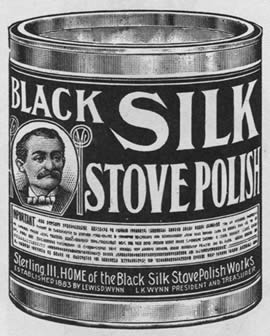 |
 |
|
| STOVE POLISH Black Silk Paste Stove Polish, in 5 lb. cans. Price, $1.40 | WABASH CRYSTAL STOVE BOARD Wood Lined..... Write for prices. |
The man’s job was only to take down the stovepipe, get it outside, hopefully without accident, where it could be cleaned, and move the stove to its summer storage place. After these two simple steps, he was to clean the flue
[14]
opening and place the cover over it--a round cover with a pretty colored picture framed by a rim of gleaming metal.
ELBOWS 6-inch blue steel. Price per dozen, $1.00
|
STOVE PIPE 6-inch Perfection pipe. Price per 10 joints, $1.65.
|
FLUE STOPS Fancy Japanned tin, with ornamental center panel and folding wires. Price per dozen, $1.50. 6-inch Clark's Gem Flue Stops
|
It was usually the first step, taking down the pipe, that triggered the bad tempered curses. Any accident which could occur usually did. The Stove, accustomed to being the center of attention, fed stick after stick of stove wood, treated with respect and watchful care all winter long, seemed to take perverse delight in being as difficult as possible about being stored away for the summer. Its pipe, which had stood straight and rigid for months now buckled and crashed at the first touch of human hands. As the soot swirled, the Stove would continue to show its displeasure at being disassembled. A foot rail would fall off, diabolically aimed at the nearest human foot. A door handle would clatter to the floor; a leg, detaching itself from the stove, would stick to the metal-covered stove board protecting the floor, or the board would cling to the carpet as if glued there. Accident followed accident until the heating stove had been lugged through the house to its resting place to sulk until September.
The time required to take down a stove varied with the stove, the man, and the quality of the accidents. An hour was considered top speed, three hours about average.
[15]
Cleaning time varied, too, for the room the stove had been in, depending on the number of dropped stovepipe sections and other factors.
As the husband went off to more compatible chores, the housewife would stand in the doorway and survey the disaster area. There were soot and spilled ashes to cleanup, windows and curtains to wash, a carpet to beat, floor and woodwork to scrub, walls to be swept down with a cloth-covered broom and, most interesting of all, furniture to be rearranged. She would start to work at once. In the midst of the chaos, she was completely happy. It was Spring, and the stove had been taken down.
[27]
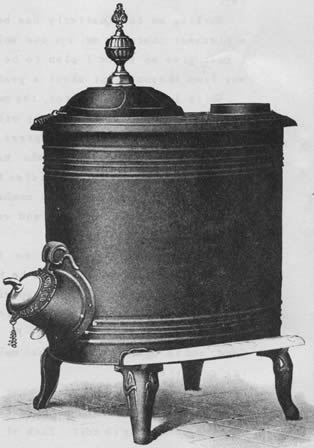
ECONOMY AIR TIGHT HEATER
26-inch, weight 78 lbs...... $9.50
Illustrations courtesy Maxine Evans.
This volume: Next Article | Table of Contents | Other Issues
Other Volumes | Keyword Search | White River Valley Quarterly Home | Local History Home
Copyright © White River Valley Historical Quarterly

